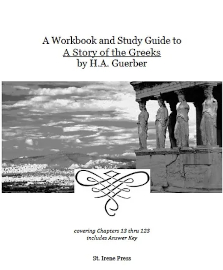The Story of the Greeks by H.A. Guerber is an older resource but one that is popular among homeschoolers. I’ve reviewed Nothing New Press’s versions of Guerber’s books, and the originals are available free online through Project Gutenberg. A Workbook and Study Guide to A Story of the Greeks by H.A. Guerber from St. Irene Press correlates with the fourth edition of The Story of the Greeks published by Nothing New Press (2009 or later). There are additional chapters in the Nothing New Press edition that are not in the original book. Three chapters at the beginning talk about the origins of the Greek people, drawing on the Bible, The Annals of the World by James Ussher (especially relying on his dates), and other sources. Three added chapters near the end (chapters 120 to 122) cover events in Judea during the reign of Alexander the Great's generals and before the occupation by the Romans.
The workbook consists of questions for most chapters of The Story of the Greeks at a level appropriate for grades five through eight. It skips past the first 12 chapters (nine chapters in the original book), many of which discuss Greek mythology. The author states in the introduction to the workbook that she chose to skip those chapters and start with the chapters that have a stronger historical basis. The workbook includes questions for chapters 120 to 122 in the Nothing New Press fourth edition of The Story of the Greeks. If you use a different version of The Story of the Greeks, you can skip these chapters, or you could have students research information on the internet and from the books of Maccabees that cover the intertestamental period in some Bibles (or are found in the Deuterocanonical books, also called the Apocrypha).
The chapters in The Story of the Greeks are often about two pages in length and can be read fairly quickly. Since the workbook covers 111 chapters, students should be able to read a chapter from The Story of the Greeks and answer the questions for that chapter on each of three or four days per week to complete the course in one year. In a personal letter, the author suggested to me that students in seventh or eighth grade read additional books from the library on ancient Greece to provide an appropriate amount of course content. (The Story of the Greeks includes a two-page list of recommended reading which includes the numbers of the corresponding chapters.)
Many workbook questions require short answers, while some require a sentence, and others a paragraph or more. (Some questions specifically tell students to answer with at least two, three, or four sentences.) Questions are often at the comprehension level, but some ask for explanations that require deeper thinking. There are also occasional narration questions such as this one for Chapter 85: “Please summarize the story of Damon and Pythias in your own words using at least five sentences, but no more than ten sentences.” The amount of writing involved in answering all the questions should satisfy composition requirements for the year.
I spotted two optional assignments, both for Chapter 38. One asks students to “Sketch the amphitheater as described” and the other presents a series of opinion questions that ask students what Solon might have thought of modern forms of entertainment and whether they agree with Solon’s assessment of the Greek theater.
The answer key is the second half of the book. It has all the student questions with suggested answers printed below each question.
The workbook and answer key are available as a single purchase either as a printed book or a downloadable PDF. You are given permission to copy question pages for your own family, but it might be easier to print pages from the PDF if you are teaching more than one student.
Summary
A Workbook and Study Guide to A Story of the Greeks by H.A. Guerber should be a very useful resource for those who want to read The Story of the Greeks and need an ancillary resource to help reinforce the information for students.









